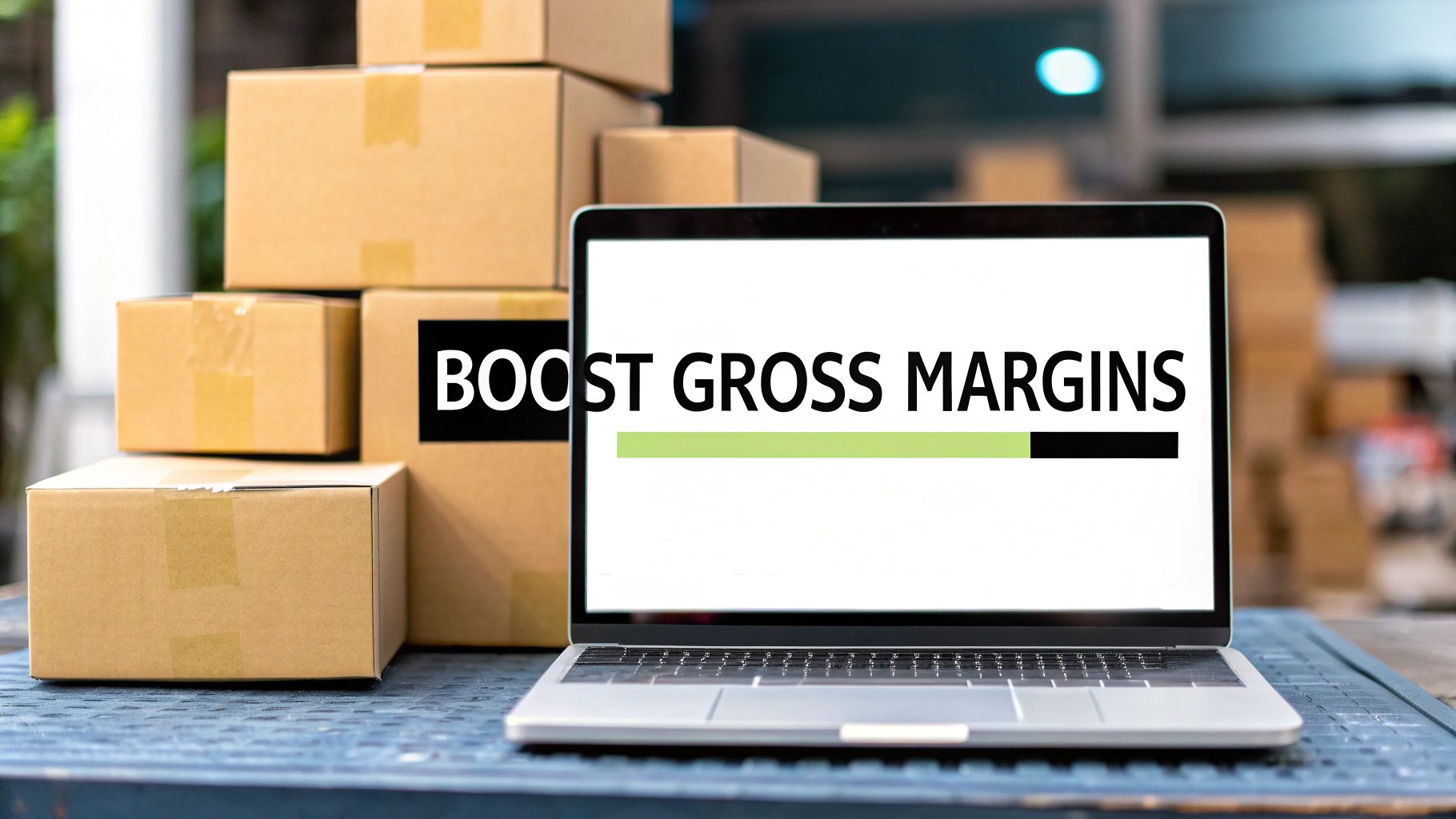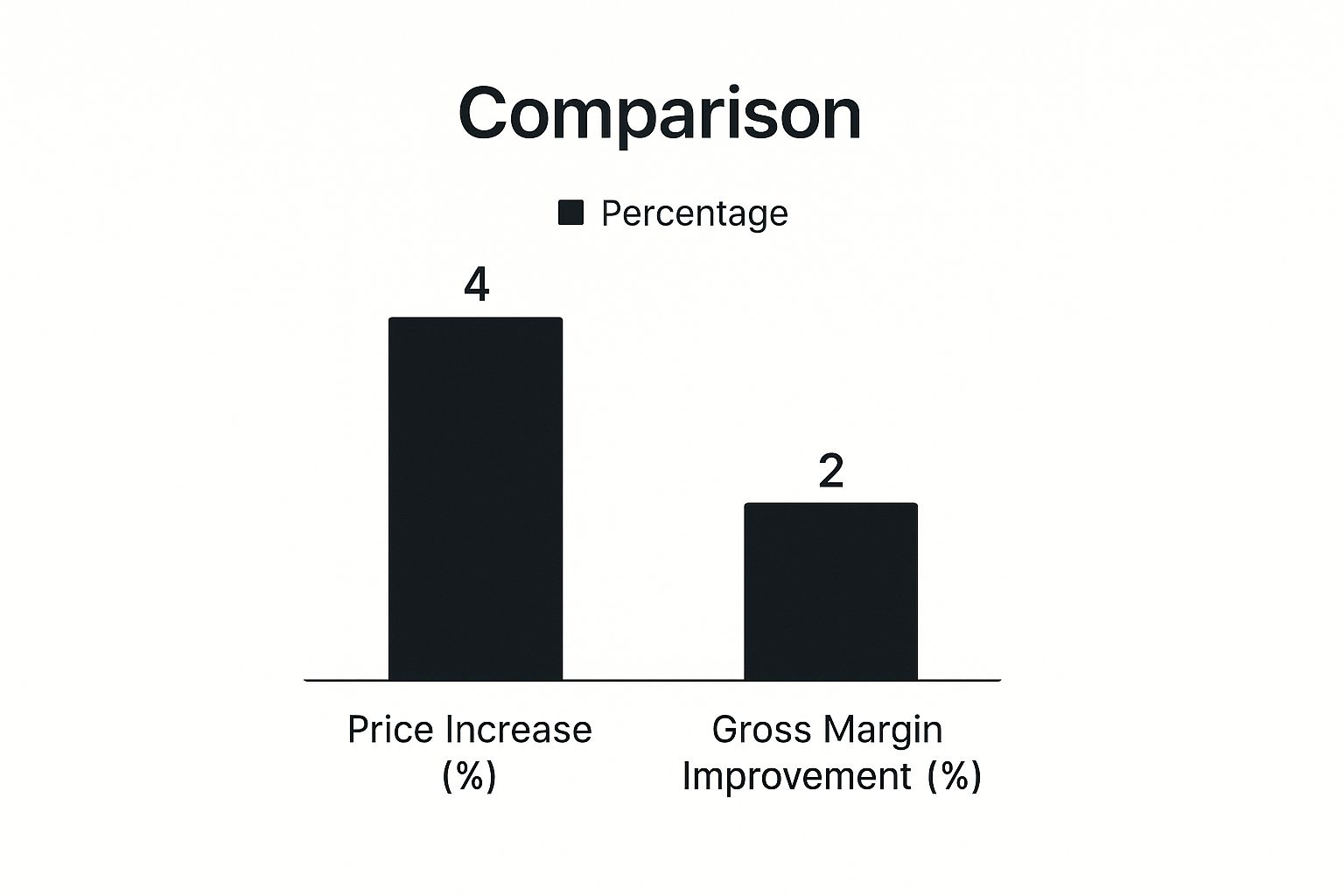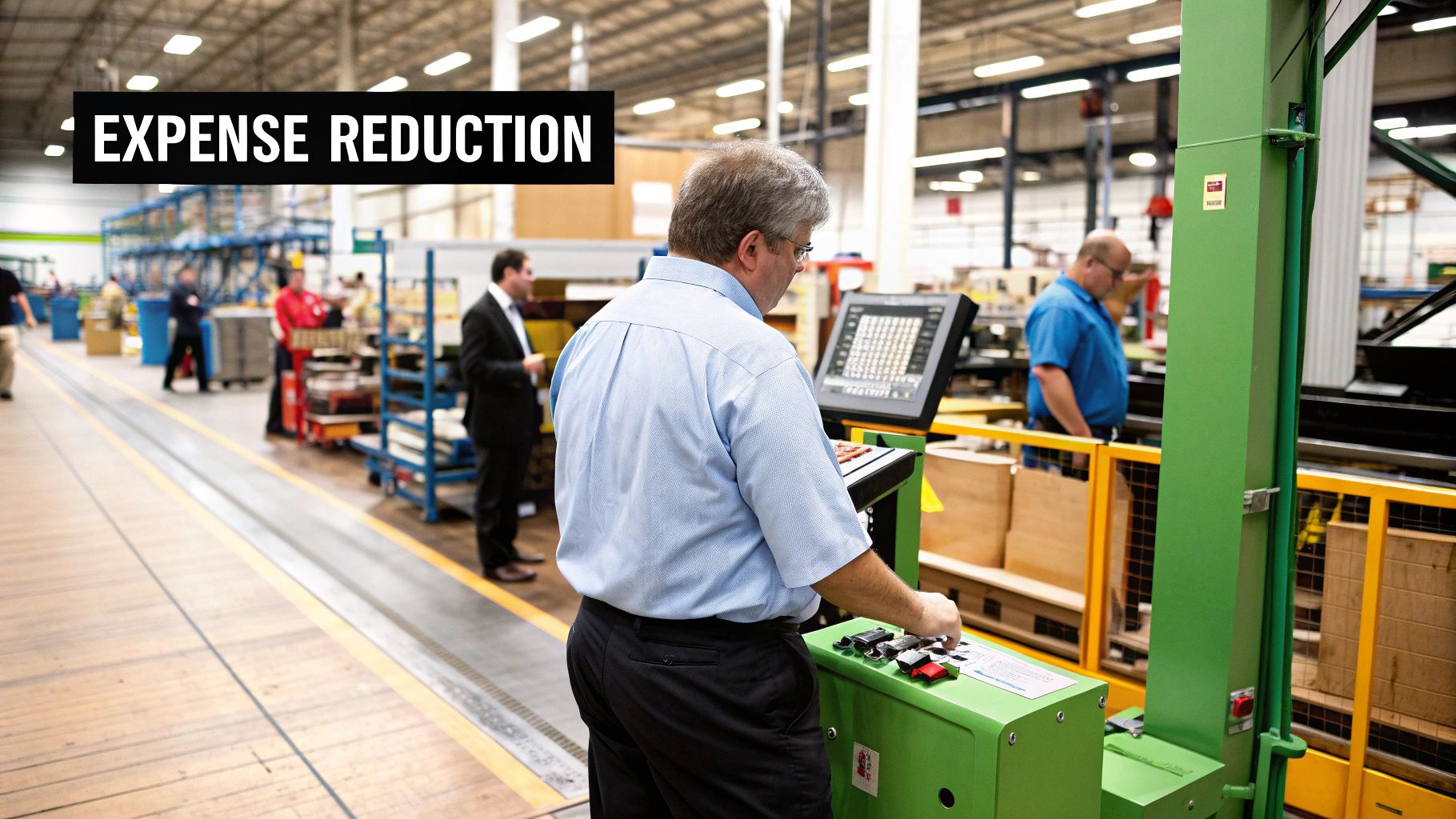Stay Updated with Everything about MDS
Thank you! Your submission has been received!
Oops! Something went wrong while submitting the form.

Chilat Doina
October 4, 2025
When it comes to improving your gross margin, it really boils down to two things: increasing the revenue you make from each sale or decreasing the direct costs of making that sale. It’s the single most important measure of your e-commerce business's financial health, telling you exactly what you have left over to fund growth, marketing, and day-to-day operations.
Let's be real, running an e-commerce business is a constant balancing act. You're juggling marketing, customer service, and a dozen other things, but at the end of the day, profitability is what keeps the lights on. That’s where your gross margin comes in—it's the metric that cuts through the noise and shows you your core profitability.
Forget the dry textbook definition. Just think of it as the money left from each sale to pay for everything else. This guide gets straight to the point, outlining the core strategies you can actually use to boost that number.
Before we dive into the specific tactics, it's critical to have a solid grasp of the metric itself. I highly recommend reading our detailed breakdown that explores what is gross margin and why it's so fundamental to your business's success.
To truly move the needle on your gross margin, you need to focus your efforts. I've found that concentrating on four key areas is where you can make the biggest, most immediate impact on your bottom line.
Here’s where we’ll be focusing:
A healthy gross margin isn't just a number on a spreadsheet; it's the lifeblood of a sustainable e-commerce brand. It provides the financial cushion to innovate, weather market changes, and invest in long-term growth.
This guide is designed to be a clear roadmap with real-world advice, not just abstract theories. To give you a high-level overview of where we're headed, I've put together a table summarizing these strategic pillars.
For a broader look at financial health, exploring strategies on how to improve profit margins can offer valuable perspectives that apply across your entire business.
This table gives you a quick snapshot of the key areas e-commerce founders can focus on to improve their gross margins, along with some specific actions for each pillar.
Think of these four pillars as your strategic foundation. In the following sections, we'll unpack each one with actionable steps you can start implementing right away.
Pricing is your single most powerful lever for boosting gross margins, yet so many e-commerce founders treat it like an afterthought. It's easy to fall into the "cost-plus" trap: figure out your costs, slap on a standard markup, and call it a day. But that’s leaving serious money on the table.
It’s time to get way more strategic. The real magic happens when you stop anchoring your prices to what your product costs you and start anchoring them to what customers believe your product is worth. When you get this right, you can justify higher prices, capture more value from every single sale, and watch your gross margins climb.
Value-based pricing is a total mindset shift. Instead of asking, "What did this cost to make?" you start asking, "What problem does this solve for my customer, and what is that solution worth to them?"
Think about it. A brand selling ergonomic office chairs isn't just selling metal and mesh; they're selling comfort, better focus, and relief from nagging back pain. That has a much, much higher perceived value than the sum of its parts.
To pull this off, you have to get inside your customers' heads. You need to know their pain points, what they aspire to, and how your product makes their life better. Once you truly understand the value you deliver, you can price your products with confidence. For a deeper dive, our comprehensive guide on powerful e-commerce pricing strategies is the perfect place to start.
The power of this approach became crystal clear recently. In the wake of the pandemic, companies with strong pricing power thrived, expanding their margins even as their own costs went up. Between the end of 2019 and late 2022, U.S. consumer prices jumped by 17%. But corporate profits? They surged by an incredible 41% in the same window. How? Many brands could raise their prices faster than their costs rose, proving that pricing is an absolute beast of a tool for profitability. You can see more on how this played out in this detailed economic analysis.
A one-size-fits-all price rarely works because your customers aren't all the same. This is where tiered pricing comes in, letting you capture different segments of the market with variations of your product.
This strategy is a classic in software and subscription boxes, but it works wonders for physical goods, too. Imagine a skincare brand offering a standard bottle, a larger "value" size, and a premium gift set with a higher margin. Each tier hits a different buyer, maximizing your revenue potential.
Dynamic pricing takes this a step further, adjusting prices based on real-time market signals. This could be triggered by:
Sure, these models require more data and active management, but the potential payoff for your margins is huge.
Key Takeaway: Stop setting your prices in stone. Your pricing strategy should be as agile as your marketing, constantly adapting to customer behavior and market conditions to maximize every dollar.
Bundling is another brilliant tactic for increasing your average order value (AOV) and, by extension, your gross margin. Instead of just selling one item, you group complementary products into an attractive package—often at a slight discount compared to buying them all separately.
A fantastic example is a brand selling high-end coffee beans. They could bundle a bag of their best-selling espresso roast with a milk frother and a nice set of glass mugs. This bundle doesn't just solve the customer's "at-home barista" dream; it also helps the brand move more inventory and bank more profit from a single transaction.
The key is offering genuine value. The products need to make sense together, and the final price has to feel like a great deal. When you nail it, bundling can give your AOV and blended margin a significant lift without you having to touch your individual product prices.
The fear of ticking off loyal customers keeps a lot of founders from touching their prices. But you have to test to optimize. The trick is to do it smartly and on a small scale.
Use an A/B testing tool to show different prices to different segments of your website traffic. Watch your conversion rates and revenue per visitor for each price point like a hawk. This data-driven approach takes the guesswork out of the equation and tells you exactly how a price change will land before you roll it out to everyone.
Start small with incremental increases of just 3-5%. For most products, a change this small will go completely unnoticed by the average customer, but it can have a massive impact on your gross margin. Remember, every dollar from a price increase flows almost entirely to your bottom line, making it one of the fastest ways to improve your company's financial health.
Okay, you've dialed in your pricing strategy. Now it's time to tackle the other side of the gross margin equation: your Cost of Goods Sold (COGS).
Let's be clear—this isn't about a race to the bottom with cheap materials that will eventually torpedo your brand. It's about getting smarter, more strategic, and more disciplined with every single dollar you spend on inventory. This is where you methodically chip away at your expenses, turning seemingly small wins into significant, long-term boosts to your bottom line.
Your relationship with your suppliers shouldn't feel like you're just placing an order. Think of it as a strategic partnership where both of you can win. Don't ever be afraid to negotiate. Honestly, it's an expected part of the game, and your suppliers are ready for it.
The key is to do your homework before you even pick up the phone. You absolutely need quotes from at least two other potential suppliers. This isn't just about getting leverage; it’s about giving yourself a crystal-clear picture of the current market rates.
Once you're in the conversation, think beyond just the per-unit price. Here are a few points I always bring up:
Never assume the first price you're quoted is the final price. A well-prepared, professional negotiation is one of the fastest ways to directly reduce your cost of goods sold and instantly improve gross margins.
This is a pretty straightforward relationship: the less you pay for your goods, the healthier your margins become.

As you can see, even a small drop in what you pay for your products can lead to a surprisingly big jump in your gross margin.
Effective negotiation is a skill, and different tactics work better in different situations. Here's a quick breakdown of some common approaches to help you decide what might work best for your business.
Choosing the right tactic often comes down to your current business needs—whether it's immediate cost savings, better cash flow, or long-term stability.
Putting all your eggs in one supplier's basket is a huge, unnecessary risk. Think about it: a factory fire, a shipping crisis, a sudden political issue, or an unexpected price hike can bring your entire operation to a screeching halt.
Diversifying isn't just about playing defense, though. It's also a powerful tool for improving your gross margins.
When you work with multiple suppliers, you naturally create competition. This keeps your primary supplier honest on pricing and gives you real leverage during negotiations. It also exposes you to new materials, different manufacturing techniques, and potential cost savings you would have never found otherwise.
How your inventory actually gets to you is a part of your COGS that many founders just accept without question. They take whatever shipping costs their supplier arranges, but trust me, there's almost always a ton of room for savings here.
Start by auditing your inbound shipping. Are you using the most cost-effective methods? Air freight might be necessary for small, urgent orders, but for your larger, planned inventory buys, sea freight is almost always dramatically cheaper.
You should seriously consider working with a freight forwarder. These companies are logistics specialists and can often find much better rates than your supplier because they consolidate shipments from tons of different businesses. When it comes to slashing your cost of goods sold, implementing smart strategies for reducing procurement costs is a must, and logistics is a massive piece of that puzzle.
Another easy win? Consolidate your orders. Instead of placing four small orders a month, can you place one large one? This move not only cuts down your per-unit shipping cost but also simplifies your receiving process, saving you time and labor—costs that add up fast.
Once you've nailed your pricing and trimmed down your COGS, it's time to go on a hunt for the hidden profit drains in your business. Some of the biggest leaks bleeding your gross margin aren't found in supplier contracts or on price tags; they're buried deep within your day-to-day operations.
Fixing them isn't about some massive, expensive overhaul. It’s about making smart, incremental changes to your inventory, fulfillment, and workflows that add up to a much healthier bottom line. These are the adjustments that directly protect your profits.

Every unsold product sitting on a shelf is cash you can't use. Inventory carrying costs—all the expenses tied to storing unsold goods—can quietly eat up 20-30% of your inventory's value each year. That's a direct hit to your margins.
The goal here is to stop guessing and start treating inventory management like the science it is.
A powerful strategy is to adopt a Just-In-Time (JIT) inventory model. Instead of buying huge amounts of stock and just hoping it sells, you order inventory much closer to when you actually need it. This dramatically cuts your carrying costs and frees up capital that would otherwise be tied up in dusty boxes on a shelf.
Don't let your warehouse become a product graveyard. Every dollar stuck in slow-moving inventory is a dollar you can't invest in growth, marketing, or higher-margin products. Active management is non-negotiable for a healthy gross margin.
This shift definitely requires a deep understanding of your sales cycles and having suppliers you can count on, but the impact on your cash flow and margins is immediate.
Fulfillment is another area just packed with opportunities to pad your gross margins. From the moment an order is picked to the final delivery scan, every single step has a cost—and every cost can be optimized.
Start by looking at your shipping. Are you constantly reviewing your carrier rates? Shipping isn't a "set it and forget it" expense.
These small tweaks in your fulfillment workflow can lead to some seriously significant savings that flow directly back into your gross margin.
Labor is a major operational expense, and any inefficiency here directly dents your profitability. This is where automation can be a total game-changer, not by replacing people, but by empowering them to work smarter.
Think about simple automation in your order processing. Software can automatically route orders, generate pick lists, and print shipping labels, freeing up your team from mind-numbing manual tasks. This not only slashes labor costs per order but also boosts accuracy.
This focus on operational excellence is a key differentiator for high-performing companies. For instance, recent analysis shows North American firms have significantly outpaced their global peers in margin growth. Between 2015 and recent years, they boosted their net operating profit after tax margin from 8.4% to 10.7%. This advantage shows how sharpening your operations can be even more impactful than just having a global scale. You can discover more insights about these margin improvements.
Even small-scale warehouse management systems (WMS) can optimize picking routes, telling your team the most efficient path to grab items for an order. It seems like a small thing, but shaving minutes off every single order adds up to massive labor savings and a much healthier margin.

Too many e-commerce brands treat marketing as a necessary evil—a black hole for cash that eats directly into their hard-earned profits. It's time to kill that mindset. Your marketing should be a powerful engine for margin growth, not just a way to buy revenue.
The whole game changes when you shift from blindly chasing sales to strategically acquiring the right customers. This means building a marketing machine that doesn't just make the sale but actually strengthens your gross margin with every single conversion.
Let’s cut through the fluff of vanity metrics. The one true sign of a healthy, sustainable marketing strategy is the ratio between Customer Lifetime Value (LTV) and Customer Acquisition Cost (CAC).
Think of it like this: LTV is the total profit you'll likely make from a single customer over their entire relationship with you. CAC is what you paid to get them in the door. For your business to have a real pulse, your LTV needs to be way higher than your CAC. The gold standard is a ratio of at least 3:1.
When you obsess over this ratio, your questions change. You stop asking, "How can I get more sales?" and start asking, "How can I acquire more high-value customers for less money?" That subtle shift is everything. If you want to go deeper, our guide on how to lower customer acquisition cost is packed with tactics you can use today.
It’s a hard truth: not all customers are created equal. Some will make a single, low-margin purchase and vanish forever. Others become raving fans, snapping up your highest-margin products time and time again. Your marketing dollars should be laser-focused on finding more of the second type.
Get into your sales data and find the common threads that link your best customers:
Once you have this profile, you can build lookalike audiences for your ad campaigns on platforms like Facebook and Google. This data-driven approach stops you from wasting money and ensures you're fishing where the most profitable fish are actually biting.
Stop casting a wide, expensive net. True marketing efficiency comes from identifying your ideal, high-margin customer and then finding more people who look just like them. Every dollar spent on the wrong audience is a direct hit to your bottom line.
Here's a rookie mistake I see all the time: running generic ad campaigns promoting the entire brand or the most popular—but not most profitable—products. To actively grow your gross margins, you have to get more granular.
Put your highest-margin products front and center in your ad creative and on your landing pages. If you have a product with a 70% margin, it deserves way more ad spend than one with a 35% margin, even if the latter sells a bit more volume. Pushing these cash-cow items directly boosts the blended margin of your entire sales mix.
This creates a powerful feedback loop. By acquiring new customers through a high-margin product, their very first transaction is more profitable, giving you a much healthier starting point to build a killer LTV.
Every dollar you spend getting a visitor to your site is completely wasted if they bounce without buying. This is why Conversion Rate Optimization (CRO) is a non-negotiable part of a margin-focused marketing strategy.
Start with your landing pages and A/B test the critical elements relentlessly.
Even a tiny lift in your conversion rate, say from 2% to 2.5%, means you're getting more sales from the exact same ad spend. This immediately drops your effective CAC, widens that LTV-to-CAC gap, and feeds right back into a healthier gross margin.
Once you start digging into the numbers, a few common questions always seem to pop up. Founders want to know what a "good" margin actually looks like, or where they can get the quickest wins without turning their whole business upside down.
Let's tackle the questions we hear most often to clear up any confusion and get you on the right path.
There’s no magic number here. A "good" gross margin can vary wildly depending on your niche and business model. What’s fantastic in one industry might be a total disaster in another.
A direct-to-consumer (DTC) fashion or beauty brand, for instance, might be shooting for margins of 60% or more, thanks to strong brand loyalty and higher perceived value. But if you’re reselling consumer electronics, where the competition is fierce and markups are thin, hitting 20% could be a massive win.
The best way to figure out your target is twofold:
At the absolute minimum, you need to be calculating and reviewing your gross margin monthly. This gives you a regular pulse check on your business's core financial health and helps you catch trends before they become major issues.
But honestly, if you're in a volatile market where your shipping costs or raw material prices are always bouncing around, a weekly review is much smarter. It lets you spot a negative trend and react before it has a chance to snowball and wipe out your profits.
Waiting a full quarter to check your margins is like driving with your eyes closed. In e-commerce, one bad month can erase a quarter of hard work. Frequent, even weekly, reviews are your best defense.
The good news is that many modern accounting and inventory platforms can track this stuff for you in near real-time. That’s the ideal setup for making quick, data-driven calls.
Absolutely. Raising prices is just one tool in the toolbox, and it's not always the best one to grab first. Plenty of successful brands put all their energy into the other side of the equation: aggressively cutting their Cost of Goods Sold (COGS).
What does that look like in practice?
Another powerful move is creating strategic product bundles. By packaging complementary items together, you can seriously boost your average order value (AOV). This often lifts your overall blended margin without you ever having to touch the price of an individual product.
For the fastest, most direct results, start with your pricing—specifically for your top-selling products. You'd be surprised how much of an impact a small price bump of just 3-5% on a high-volume item can have on your gross margin. It's often an immediate win.
The second place to look for quick wins is your shipping and fulfillment costs. These expenses can often be renegotiated with carriers or optimized through smarter packaging choices. Every dollar you save there goes straight to your bottom line.
While hammering down your COGS with suppliers is a huge lever for long-term health, those negotiations often take more time and effort to bear fruit.
At Million Dollar Sellers, we believe mastering your margins is non-negotiable for building an 8- or 9-figure brand. Our exclusive community is for serious e-commerce founders ready to scale smarter by sharing proven, high-level strategies on everything from sourcing and pricing to ops and marketing. If you’re ready to learn from the best in the business, find out if you qualify to join us at Million Dollar Sellers.
Join the Ecom Entrepreneur Community for Vetted 7-9 Figure Ecommerce Founders
Learn MoreYou may also like:
Learn more about our special events!
Check Events